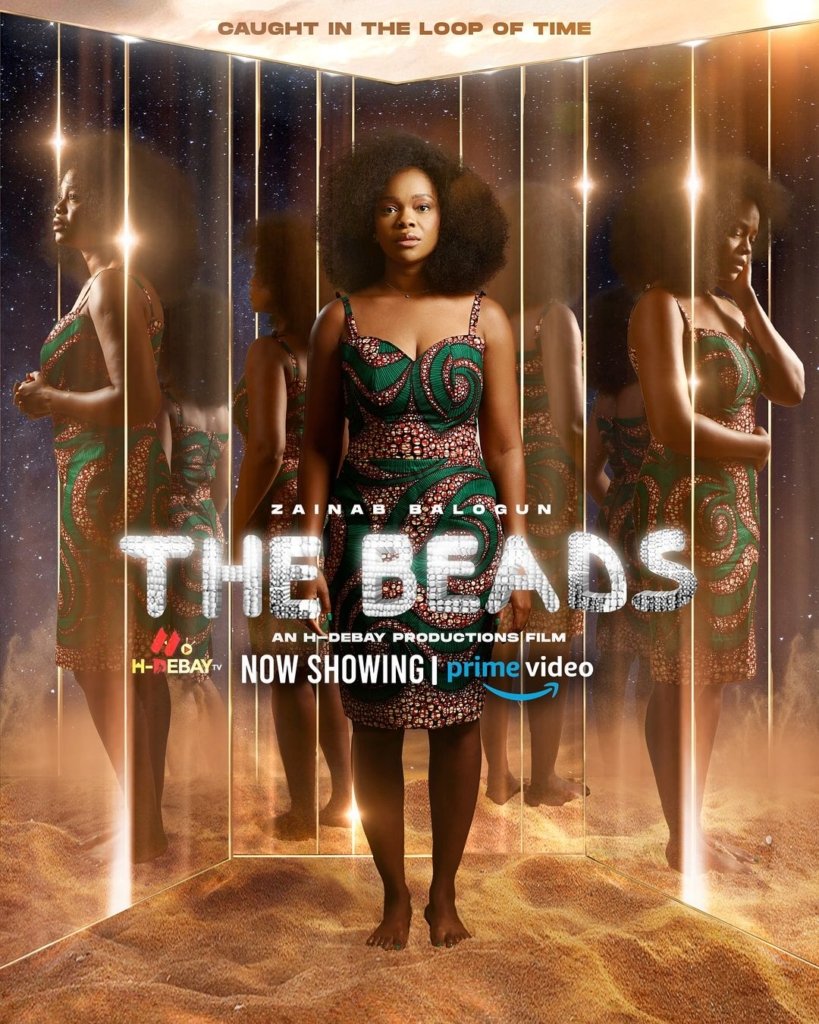The Beads: A Tortuous Loop
Zainab Balogun, Shaffy Bello, Adedimeji Lateef, Ewa Iwara, Idowu Phillips, Segun Arinze, Chioma Omeruah, Bimbo Manuel, Ronke Oshodi, Juliana Oloyede, Tina Mba and Jammal Ibrahim.
The Beads narrates the tale of a bride-to-be whose wedding day tragically transforms into her final day. As she struggles to survive, she yearns to reverse time, embarking on a journey through the complex web of human emotions.
1hr 40mins
Moyin Ezekiel
Akinbayo Morakinyo
Kehinde Quadri, Olalekan Uthman, Akinbayo Morakinyo, Moyin Ezekiel
2024
Prime Video
The continuity
The myriad of elements thrown into the plot
Directed by Moyin Ezekiel and produced by Akinbayo Morakinyo of H-Debay Production, The Beads narrates the tale of a bride-to-be whose wedding day tragically transforms into her final day. As she struggles to survive, she yearns to reverse time, embarking on a journey through the complex web of human emotions.
The first thing to note is that The Beads is a time loop story. This sub-genre is slowly making its mark in Nollywood productions, especially with the recent release of Japa still fresh in our minds. This raises the question: will The Beads offer something unique or captivating to this emerging genre?
In Japa, the central theme revolves around the protagonist’s desperate attempt to escape his time loop in order to travel abroad, creating a strong emotional connection with the audience. Similarly, The Beads brings a fresh twist to the time loop concept by setting it on a bride’s wedding day—a day traditionally considered the happiest for many women. The bride (played by Zainab Balogun) navigates the repetition of what should be a joyous occasion, now tinged with dread and suspense.
When working with time loops in movies, a great level of meticulous planning and precision is demanded. It’s crucial to establish clear rules governing the time loop to ensure consistency and continuity across each iteration. In The Beads, the first loop shows the protagonist immediately attempting to explain the phenomenon to her grandmother. This seems premature, as most time loop films typically portray the initial loop as a period of confusion, where the affected individual questions their reality. The protagonist’s dialogue adds to the confusion, as she speaks to her grandmother (played by Idowu ‘iya rainbow’ Phillips) as if she has experienced the loop multiple times, even though this is the first loop presented to the audience.
However, this dialogue flaw is corrected by the second loop, where the protagonist clearly states that she has already lived through the day twice. This adjustment helps to align the story with the established conventions of the time loop genre, ensuring that the protagonist’s journey is believable.
Despite this minor dialogue issue, the film maintains overall continuity in its depiction of the time loops. Each iteration introduces slight variations that align with the unfolding plot, contributing to a sense of natural progression. When more significant changes occur, they feel like a logical escalation of these subtle differences, enhancing the story without disrupting the established flow.
While The Beads is initially easy to follow, as the movie progresses, numerous questions arise about the filmmakers’ choices. The film introduces a variety of themes into the time loop, creating a sense of overcrowding and ambiguity about their purpose. For instance, Ranti, the bride, is revealed to be in recovery from substance abuse—a detail that adds little to the time loop narrative. Additionally, the film briefly touches on her past illness, which is seemingly intended to portray her as someone struggling with a desire to live. However, these elements fail to enhance the time loop’s significance.
The loop is presented as an existential event meant to rekindle Ranti’s love for life. Despite this intention, the events within the loop do not convincingly explain why she eventually wants to embrace life. Instead of serving as a profound catalyst for change, the loop comes across merely as an inconvenience she wishes to escape. The lack of depth and coherence in tying these elements together undermines the film’s potential to deliver a meaningful message through its time loop narrative.
In the final quarter, Ranti’s father (Bimbo Manuel) emerges as a significant figure due to his actions that triggered the villain’s pursuit of Ranti’s life. While the resolution of the time loop aims to bring closure to the villain and his wife, it notably overlooks Ranti’s father. He is intricately linked to the events of the loop, potentially more so than Ranti, yet remains largely unaware of its unfolding.
The Beads portrays Ranti’s father’s insensitivity, and possibly his greed, as catalysts for the loop’s inception. However, by the conclusion, he experiences no repercussions or pivotal moments stemming from this revelation. This oversight is particularly egregious because it denies him the opportunity for repentance or reconciliation with the villain (Segun Arinze). The story fails to address his role in initiating the loop, leaving his character arc unresolved and disconnected from the thematic resolutions explored elsewhere in the film.
The Beads also raises a multitude of questions by the time the credits roll. How does Ranti know that the documents she needs to trace the villain are in her dad’s room and on his table? Why are the documents on the table and the first thing on it? Why will her father who seems to be keeping the case a secret leave the documents carelessly and within reach of anyone looking for them especially after he just had a conversation pertaining to it with his daughter? Why did the villain have an official invite on his table at home considering he broke into Ranti’s house during the drowning scene? What was the real reason behind the loop? While one could hypothesize that the beads initiated the loop to save Ranti’s life after her father’s actions put her in danger, the film’s inclusion of various other elements and explorations suggests a more complex explanation may be necessary, rather than a straightforward solution.
The performances in The Beads are neither laudable nor are they terrible; they effectively serve the film’s storyline without surpassing (or necessarily achieving standout moments) or falling short of expectations. However, the bridesmaids stand out with notably lackluster performances that detract from the overall ensemble.
In conclusion, The Beads offers a Nigerian perspective on the time loop subgenre, introducing intriguing elements regarding how the beads initiate the loop, albeit without thorough exploration. The film presents a compelling exploration of the time loop narrative against the backdrop of a bride’s significant day. It delves into themes of redemption and existential discovery, although it falters at times with unresolved plot points.









